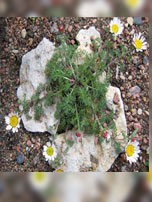SHAHEED KARTAR SINGH SARABHA AYURVEDIC MEDICAL COLLEGE & HOSPITAL
Affiliated to Guru Ravidas Ayurved University, Hoshiarpur Punjab
Affiliated to Guru Ravidas Ayurved University, Hoshiarpur Punjab

Botanical Name: Anacyclus pyrethrum DC
Family: Compositae; Asteraceae.
Introduction:
Latin name : Anacyclus (Ana like, kyklos -= circle); prethrum (pyr- fire due to pungent roots)
The plant does not appear to be of Indian origin because it is not mentioned in Chanka samhita. But Bhavaprakash has described this plant just as he has mentioned tobacco plant which is not of Indian origin. Akarkarabh must have come from Afghanistan.
Names in different Indian languages:
English : Spanish, Pellitory,Pyrethrum Root,pellitory
Hindi : akarkara
Kannada : Akkalakara
Malayalam : Akkikkaruka,akkravu
Sanskrit : Akarakarabhah, agragrahi
Tamil : Akkiraakaaram
Telugu : Akarakaramu
Unani : Aakarkarhaa
Synonyms:
Aakaarakarabha, Aakallaka, Aakulakrit, Agragraahi.
Anacyclus officinarum Hayne
Varieties & adulterants – (CV – controversy, AD – adulterants)
Spilanthes acmella
Morphology:
Creeping perennial pant, numerous branches, brown in colour, bitter in taste.
Root — 7 to 10cm. in length. It Is interesting
to note that its root protects its potency till 7 years.
Leaves — small, like the leaves of lcapittha.
Flowers — round in shape, flowering occurs in summer. Petals — white, pink, yellowish on the upper side.
Fruits — shallow, oval in shape.
Distribution & Habitat:
Northern Africa, Arabia Syria, Bengal. (There is a plant whichis called false akarkarabh,)
Chemical constituents:
anacycline, isobutylamide, inulin
Properties:
Rasa : kashaya,tikta
Guna : ruksha, tikshna, katu;
Veerya : ushna
Vipaka ; katu
Karma : balyam, hridyam, sulaghnam
arminative, digestive,astingent,bitter, aphrodisiac, ,antimicrobial, antifungal, anthelmintic, antiviral, anti-inflammatory
Srotogamitva:
Dosha Kaphagh, vataghna pittavardhak
Dhatu Majja (.weakness), shukra (virilization).
Mala : Mutra (prameha).
Organs : Heart, lungs.
Indications:
Pratisyaam, sukramutra amaya, sopham,
Toothache , rhinitis, fever, skin disease, cough, piles, leucorrhoea, diabetes, vomiting, dysentery, gout,
Part Used:
Whole plant
Dosage:
Leaf juice 10-15 ml
Powder 2-4 g
Decoction 50-100 ml
External uses :
Akkalkara is used with oil for massage in hemiplegia and nervine debility. Decoction alakarkarab root is used for gargling In dental caries, toothache and tonsillitis. In abscess, it is applied externally for assimilation and damn. By its application skin becomes reddish and boils occur. It is applied externally as an analgesic Its nasya is given in chronic rhinitis and cold. It is used in various aphrodisiac oils prepared in unani medicine.
Internal uses :
It Is used internally in various types of vata disorders A small dose of akarkarabh acts as an appetite stimulant in indigestion and pittakshaya. It increases heart rate. It is used in sexually transmitted diseases and inflammation. Useful in cough and hoarseness of voice. It is also used in children like Achorus calamus It is useful in diabetes. Itis also helpful in impotency caused by weakness of nerves. It is used as rasayana in kaphaj diseases.
If the root powder is given in a dose of more than 0.5 to 075 gm., it results in nausea, bleeding increase In heart rate, unconscious, etc In such conditions, milk and other pittashamak dravyas should be used as antidotes
Therapeutic Uses:
Flower and root useful in toothache
